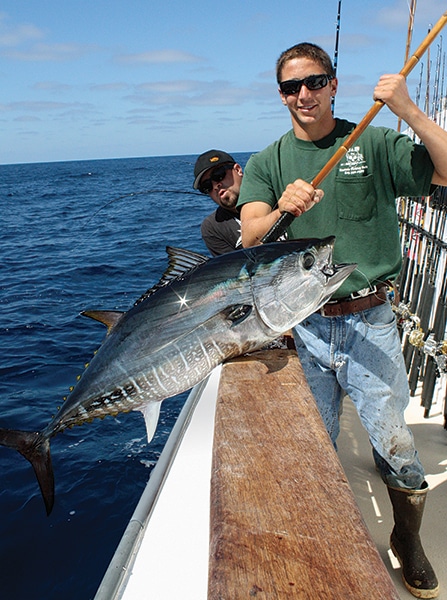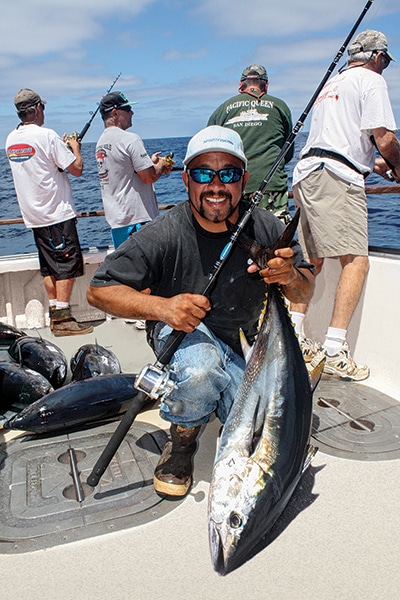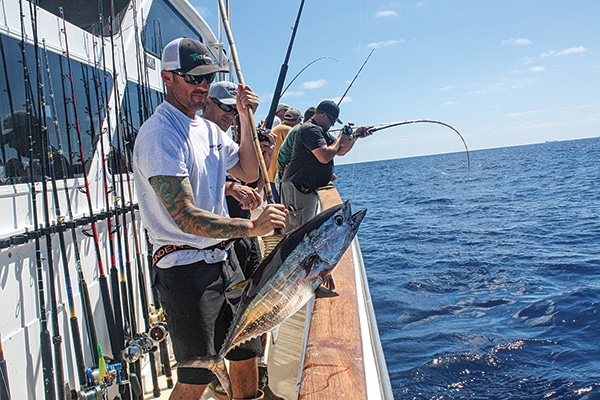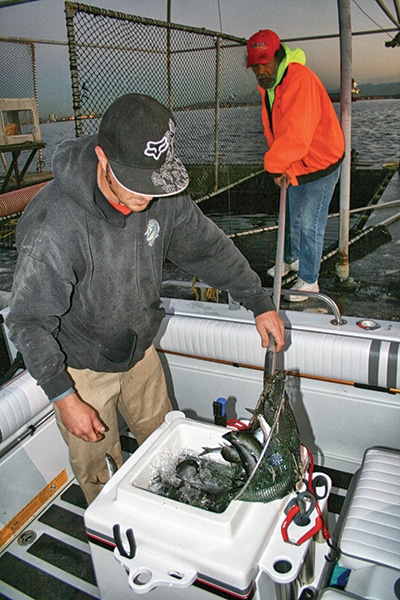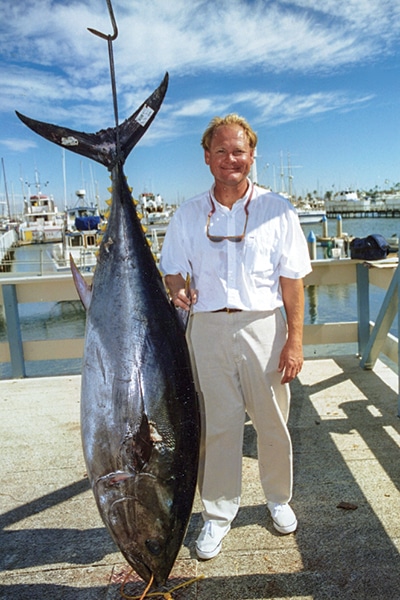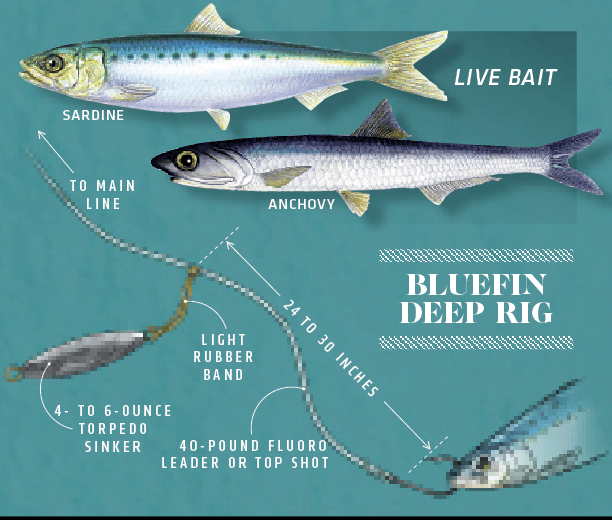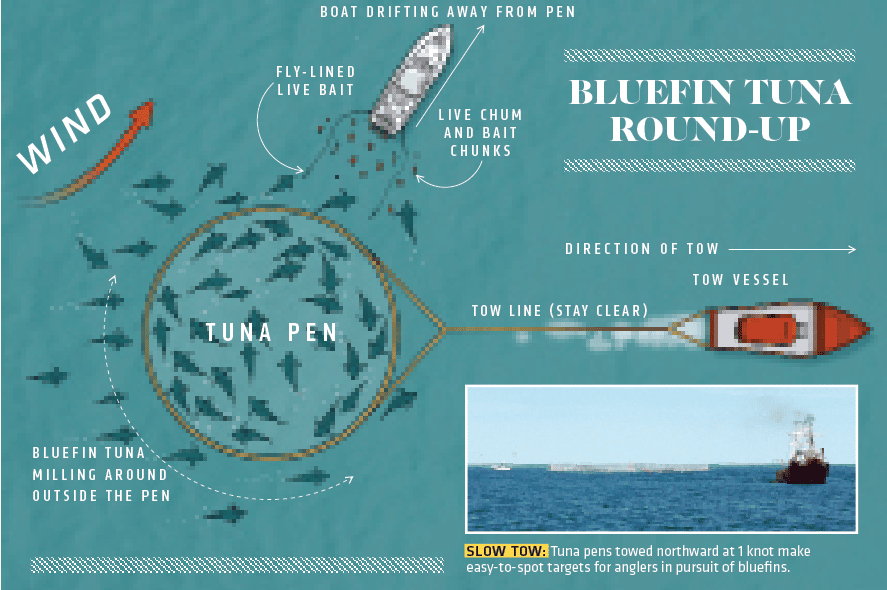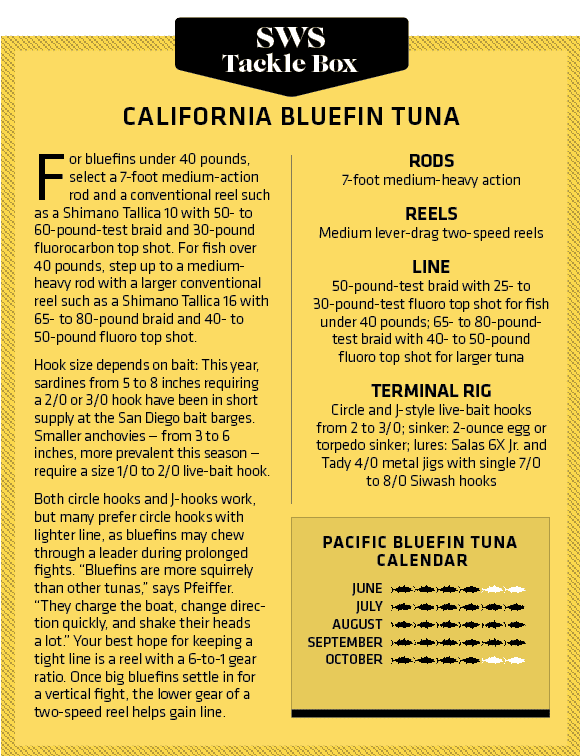**We ran our 23-foot center console 60 miles below San Diego’s Point Loma in the predawn hours, and now in Mexican waters, we eyeballed our targets: circular pens of captive Pacific bluefin tuna being towed northward at 1 knot. **
The pens were destined for anchorage just below the border, where the fish will be fattened for harvest and shipped to market. Meanwhile these pens in transit become unusual fish-aggregating devices, attracting schools of free-roaming bluefins.
We set up the boat to drift away from one of the pens, and fly-lined live sardines about 150 feet behind the boat. Within minutes, we were bit — a tuna inhaled one of the baits and scorched away. Fifteen minutes later, we put the gaff in a bright 40-pounder, the first of many bluefins to bloody the deck in an epic day of fishing.
Pen Pals
There are a variety of ways to find schools of Pacific bluefin tuna, but the floating pens of live fish stand out as one of the easiest ways, according to Dave Pfeiffer, president of Shimano Fishing Tackle.
“Pen fishing is not a lot different from targeting kelp paddies,” says Pfeiffer, who fishes from his 32-foot SeaVee Trinidad. “The bluefin tuna tend to swim in large circles around the pens, just as they do around a kelp patch.”
The difference is you know where to find the pens, while you might burn fuel all day looking for a kelp paddy. Bluefin tuna also seem to have become more abundant and more willing to bite in recent years, according to Bill Roecker, who represents the San Diego passenger sport-fishing fleet and has fished for Pacific bluefin tuna since 1980. “By late summer or early fall, the commercial guys have usually reached their quotas,” Roecker explains. “That translates to more bluefin for recreational fishermen, and with less commercial pressure, the fish aren’t quite as touchy.”
This also gives the bluefin a chance to get bigger. This year, anglers have landed fish in the 120-pound range, and larger fish might be in the offing.
Pen Point
The search for tuna pens begins before you leave. Local fishing websites have become one of the best ways to get a bead on the position of the pens. Some anglers post the latitude and longitude of a pen after a successful day of fishing. There might be 10 or 12 pens under tow, all moving slowly northward. Tuna might be holding around any or all of them at any given time.
The general location of the pens tells you how far you need to run and whether your boat has the range to get there and back. Also, take weather into account: On rough days, you burn more fuel than when the seas are smooth.
Most boats leave for the tuna grounds in the wee hours — some as early as 11 p.m. the evening before — after baiting up at the live-bait barges in San Diego Bay or Mission Bay. The early departure allows for an arrival at the pens — which might be more than 60 miles below the border — at first light.
Most offshore boats run with radar to detect other vessels and hard targets such as the Coronado Islands 14 miles south of Point Loma. Tuna pens also carry radar reflectors, and the tugs themselves generate strong returns. It’s prudent to steer well clear of the pens, tugs and tow lines until daylight, when you can clearly see where everything is.
Setting Up
Skirted lures (known locally as “tuna feathers”), cedar plugs and deep-diving lures — in dark colors, such as purple — work well by the pens in the early hours, and it’s not unusual to hook a tuna or two at first light.
Sometimes a school will follow the hooked fish to the boat. Tossing out a few live “chummers” helps hold the school as anglers cast live baits. However, private boats usually play it conservatively with the live chum, as this quickly depletes a live-bait supply. Passenger sport-fishing boats, on the other hand, carry more bait and chum more heavily.
More common than trolling is drift-fishing the pens. This involves positioning downwind and slightly ahead of a pen while fly-lining three or four live baits.
Schools of bluefins sometimes roam widely around a pen, as much as a mile or two away, according to Pfeiffer. “Sometimes you need to drift baits for quite a long time before you get a bite,” he says.
Whether trolling or drifting, safety dictates that you give the pens, tugs and tow lines a wide berth. There’s no need to get too close. By all means, don’t get between the tug and the pen, and avoid fishing the upwind side of the pen.
Think Deep
The bluefins are sometimes 60 to 100 feet or more below the surface. Keep your eye on the fish finder, and look for marks that reveal where the fish are holding.
When the fish refuse to come up, two techniques prove effective. The most common is dropping a heavy metal jig such as a Salas 6X Jr. or Tady 4/0, according to Roecker. “We do well with the metal jigs, especially those in chrome or blue-and-chrome,” he says.
Fish these jigs yo-yo style, dropping the jig straight down through the meter marks, then retrieving rapidly. Arming the jigs with a single, sharp 7/0 or 8/0 Siwash hook helps ensure solid hookups because treble hooks tend to tear loose during the fight, according to Roecker. The other technique is a 2-ounce egg or torpedo sinker over a live bait on a 3-foot leader.
Capt. Pat Cavanaugh, of Pacific Dawn, has a method he believes is more effective than others. He attaches a 2-ounce torpedo sinker 2 to 3 feet above the hook with a light rubber band. “When a tuna is hooked up, the rubber band breaks, allowing you to fight the fish without dragging the sinker around,” says Cavanaugh. This helps prevent the fish from tearing the hook loose, especially when it uncorks a violent headshake, which bluefin are prone to do.
Fishing the tuna pens of northern Baja California is by no means the only tactic for bluefin. Many boats start at the pens in the morning, and then later in the day move on to fishing kelp paddies, hunting for flocks of birds, looking for marks on a fish finder, and even chasing schools of breaking fish.
That’s the beauty of tuna-pen tactics. It’s a great way to start a Pacific bluefin trip, and some days the fishing is so good, you never need to go anywhere else.
